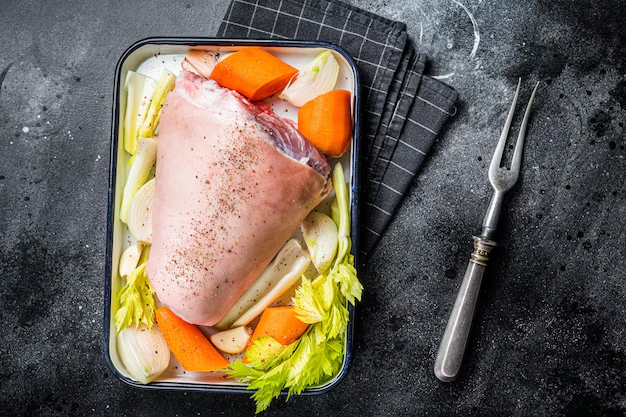How Long Can You Keep a Ham in the Fridge Without Losing Freshness?
Have you ever found yourself staring at the leftover ham in your fridge, wondering, "How long can this stay here before it goes bad?" You're not alone. Whether it's from a festive holiday feast or a simple weeknight dinner, understanding how long a ham can last in the refrigerator is essential for maintaining its flavor and safety. In this article, we'll explore the ins and outs of ham storage, provide practical tips for keeping it fresh, and help you become confident in your food storage strategies. 🥓
The Basics of Ham Storage
Ham, a staple in many households, comes in various forms, including cooked, uncooked, sliced, and whole. Each type of ham has its own storage requirements and shelf life when placed in the refrigerator.
Types of Ham
Cooked Ham: This includes hams that are fully cooked before being sold. They're often pre-sliced or spiral-cut and ready to eat cold or warmed.
Uncooked Ham: These require cooking before consumption and typically have a longer shelf life.
Sliced Ham: Usually pre-packaged and often found in deli sections.
Whole Ham: Includes both half and whole hams, which can be either cooked or uncooked.
General Shelf Life Guidelines
- Cooked and Sliced Ham: Generally lasts about 3 to 5 days in the refrigerator.
- Uncooked Whole Ham: Can last 5 to 7 days if stored properly and remains unopened.
- Opened Uncooked Ham: Typically remains fresh for 3 to 5 days.
🚚 Handy Tip
For longer storage, consider freezing the ham. Cooked or uncooked, ham can be frozen to extend its life if stored correctly.
Factors Affecting Ham's Shelf Life
Storage Temperature
The temperature inside your refrigerator plays a crucial role in ham storage. Keeping your fridge at or below 40°F (4°C) is critical for slowing bacterial growth, ensuring the ham stays fresh. Utilize a refrigerator thermometer if you're unsure about your appliance's temperature accuracy.
Packaging
- Original Packaging: Often the best choice for unopened ham, as manufacturers design these to optimize freshness.
- Resealable Bags or Containers: Ideal for opened ham, as these can minimize exposure to air and moisture, which contribute to spoilage.
Cross-Contamination
Store ham away from raw meats or other foods that might pose a contamination risk. Using a dedicated sealed container ensures maximum protection.
Aging or Curing
Some meats, like prosciutto or other dry-cured hams, benefit from longer storage due to their preparation processes. The shelf life of these items can vary and is often longer compared to non-cured counterparts.
Storing Ham: Detailed Guidelines 🗂️
The Fridge Game Plan
Unopened Ham
- Vacuum-sealed, refrigerated: Leave it in its original packaging, where it can last until the labeled expiration date.
- In loose packaging: Wrap tightly in plastic wrap, aluminum foil, or in a zip-top bag.
Opened Ham
- Store in airtight containers: This helps prevent moisture loss and guards against external odors and bacteria.
- Avoid high-moisture areas: Place ham away from the fridge door or other warm spots.
Freezing Ham for Extended Storage
Freezing is your best bet for long-term storage. Here's how to do it right:
- Wrap It Up: Use heavy-duty aluminum foil or a freezer-safe bag.
- Portion Control: Cut ham into meal-sized portions to avoid defrosting more than necessary.
- Labeling: Always label with the date of freezing to track its life cycle in the freezer. Generally, ham can maintain quality for up to six months.
Defrosting Safely 🧊
- Refrigerator Method: Place frozen ham in the fridge, allowing one day for every 5 pounds to thaw.
- Quick Defrost: In urgent situations, place the ham in a sealed plastic bag and submerge in cold water, changing the water every 30 minutes.
Signs Your Ham May Have Gone Bad ⚠️
Before diving into leftover ham, it's wise to inspect it for spoilage. Here are common signs:
- Unpleasant Odor: A sour or sulfur-like smell signals decay.
- Discoloration: Grayish, brownish, or greenish hues are red flags.
- Texture Changes: A slimy or sticky surface indicates bacterial growth.
- Taste and Smell Test (Cautious): If in doubt after any tests, it's best to discard the ham.
Safety First: Eating and Serving Leftover Ham
Serving Leftovers
When serving leftover ham, ensure to heat it to at least 165°F (74°C) to kill any potential bacteria, especially if it's been stored for several days.
Limited Refrigeration Time
Remember the "two-hour rule": Food should not be left at room temperature for more than two hours. When temperatures exceed 90°F (32°C), reduce this to one hour.
Visual Summary: Ham Storage Tips 📝
Ham Storage Quick Tips:
- Cooked Ham (opened): 3 to 5 days
- Uncooked Ham (unopened): 5 to 7 days
- Refrigerator Temperature: ≤ 40°F (4°C)
- Freezing: Up to 6 months
💡 Top Tip: Carefully monitor fridge temps and avoid frequent door openings to maintain a stable temperature. This helps preserve the quality of refrigerated items, including your precious ham.
The Bottom Line ✨
So, how long will your ham last in the fridge? The answer depends largely on the type, packaging, and storage conditions. By following the outlined practices, you’ll ensure that your ham remains delicious and safe to consume for as long as possible. 🥳 Whether you’re a meal prepper or a festive feast host, these tips will keep your meals fresh and flavorful, helping you make the most out of every purchase.
Being knowledgeable about food storage is more than just understanding longevity — it’s about optimizing quality and ensuring safety for you and your loved ones. That peace of mind is something everyone deserves. Happy storing! 🍖
